Yoshimura history – 21
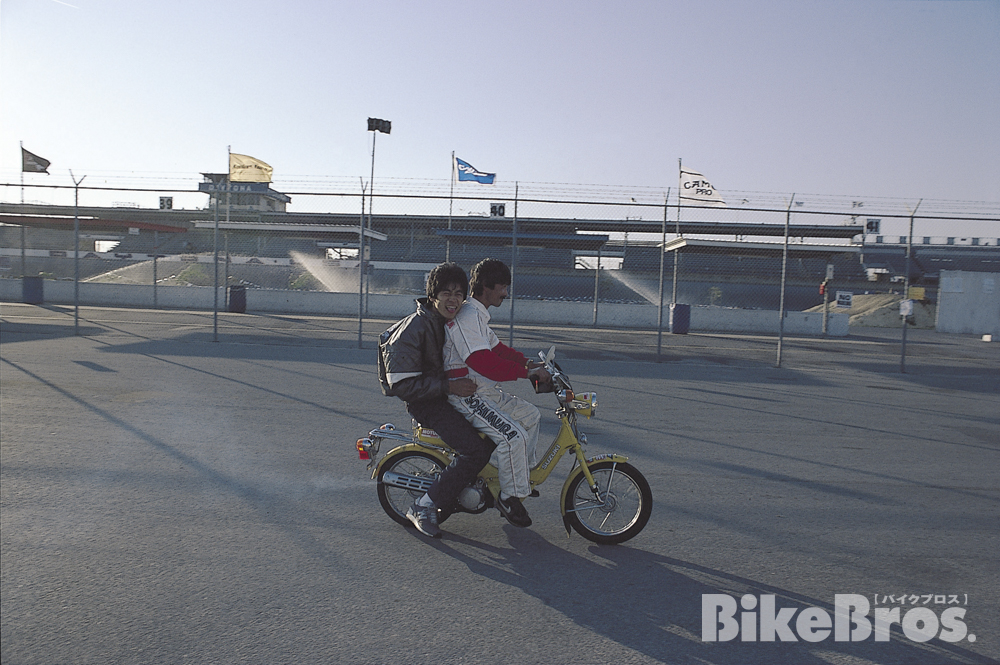
Fujio zooms around behind the Daytona pit area on a Suzuki Susie moped, with Tsujimoto on the back, on an evening in 1986. The water sprinklers in the background were deployed to wet down the temporary Supercross track which is constructed between the main road course and the pit road during the Daytona Beach Bike Week.
Yoshimura History #21: A Samurai on the 31-degree Banking
1985-1986 Daytona, Part One
In the TT-F1 class of the final round of the 1985 All-Japan Road Race Championship —— Round 11 in Suzuka on September 8th, titled as Japanese Grand Prix —— Yoshimura Suzuki rider Satoshi Tsujimoto qualified 2nd and finished 2nd in the final, winning the championship in his first year in the International A-class. His teammate and senior Shosuke Kita also finished 3rd.
The winner of the race was spot-entry Wayne Gardner on a Honda RVF750. In this season, Gardner achieved a total of 6 victories (a complete victory) in the TT-F1 and GP500 classes in 3 All-Japan road races held at Suzuka. He was indeed an active World Grand Prix rider. Through his riding, he showed All-Japan riders how to power slide a motorcycle —— the most advanced technique in Grand Prix racing at that time —— and get maximum performance from radial tires.
Tsujimoto won 3 out of 8 TT-F1 races to become champion and finished 3rd in the TT-F3 ranking. Kita, on the other hand, won 1 race in TT-F1 and was ranked 4th in TT-F1, and in TT-F3, he took 1 victory in the final Japanese Grand Prix round against Honda RVF400 riders (Yoichi Yamamoto and Masaki Tokuno), who had won all the previous races, and was ranked 8th in TT-F3 ranking. This victory was a valuable one, as the RVF400 was truly an absolute force to be reckoned with.
Before the 1985 season started, Hideo “Pop” Yoshimura told Tsujimoto, “If you win the championship, I’ll take you to Daytona.” To Pop, it may have been a casual conversation with a rookie rider, but Tsujimoto had not forgotten. Daytona was a clear goal for Tsujimoto.
Pop could not take back what he said, and the decision was made to send Tsujimoto to the 1986 AMA season opener at Daytona in March.
Yoshimura had introduced a new tech in the final round of the 1985 All-Japan Road Race Championship. It was an innovative exhaust system called Duplex Cyclone, and was fitted on Tsujimoto’s TT-F1-spec GSX-R750. Like Yoshimura Cyclone, it was constructed to match the “1-2-4-3” firing order, but Duplex Cyclone has 2 tubular chambers that connect pipes #1 and #2 and pipes #4 and #3 respectively. In this way, it combines the fat low/mid range torque provided by the 4-into-2-into-1 exhaust system with the high range power and torque generated by the 4-into-1 Cyclone.
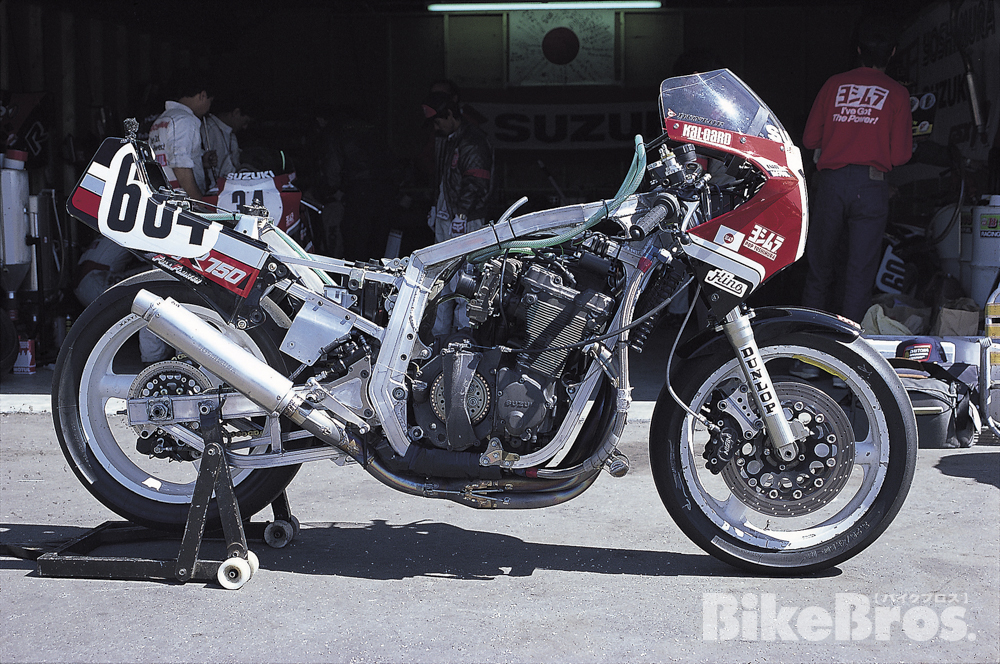
The Duplex Cyclone exhaust system was also fitted to the AMA Superbike-spec GSX-R750. Note that the tubular chambers —— connecting pipes #1 to #2 and pipes #3 to #4 —— are located on the front side of the exhaust pipe. The chambers in later versions, including aftermarket versions, were relocated to the engine side. The carbs on the bike are magnesium-bodied 36mm Mikuni TM flat-slides, available only to the factory team.
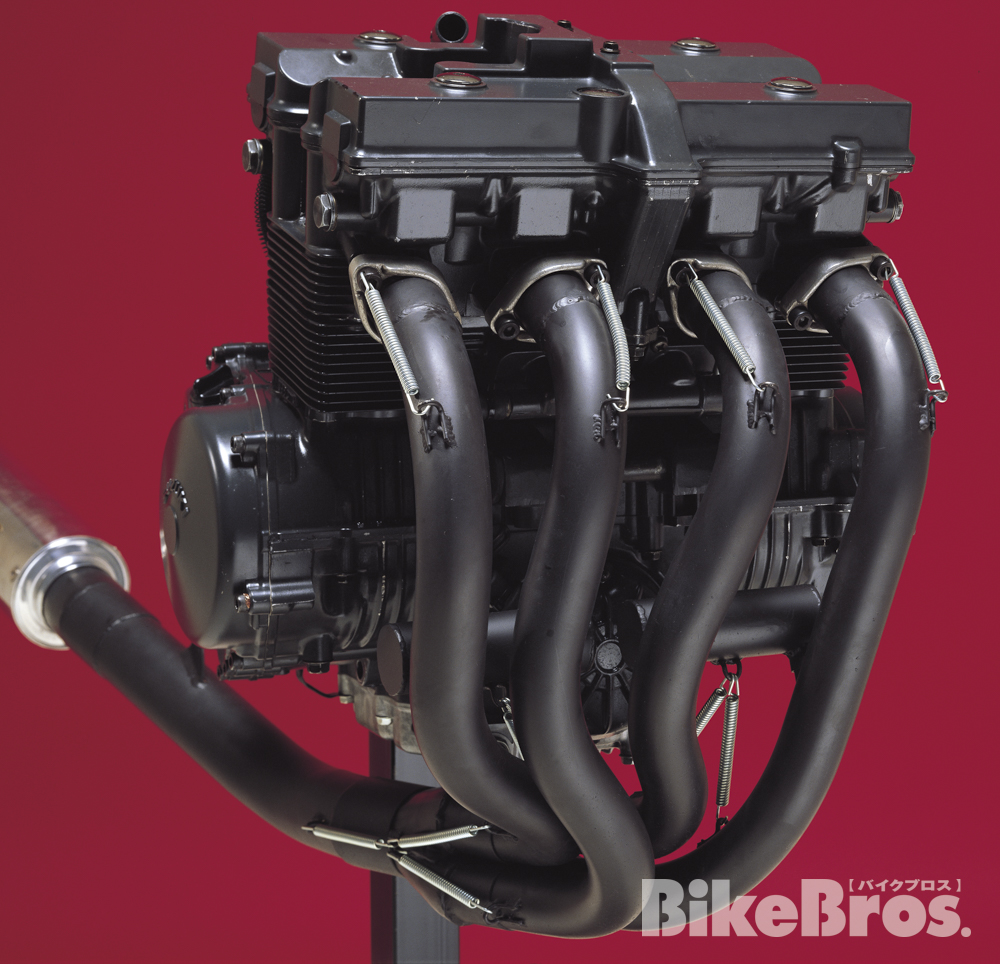
An example of an aftermarket version of the Duplex Cyclone. The chambers are on the engine side as shown.
Fujio, by carefully considering the merits and demerits of the Cyclone, had been using the conventional “2-1-4-3” 4-into-1 exhaust system —— with #1 and #4 pipes at the top, #2 and #3 pipes at the bottom —— on the AMA Superbike spec GS1000S and GSX1000S US Yoshimura (Yoshimura R&D of America) was building. Meanwhile back in Japan, Pop was using the Cyclone on the TT-F1 spec GSX1000 (including the 1983 Yoshimura Moriwaki GSX1000), 1984 GSX750E, and World Endurance spec GS1000R. This is where the father and son differ as tuners (or maybe it’s just Pop’s tenacity).
After being satisfied with the 4-into-2-into-1 set-up which Yoshimura tried once when Tsujimoto won his first All-Japan Road Race, Pop and Fujio developed the Duplex Cyclone by adding chambers to the Cyclone. The principle is similar to how the low/mid-range performance of a 2-stroke engine can be tuned by the configuration of expansion chamber. The same logic applies to today’s short exhaust system which integrates a large mid-muffler under the engine.
Fujio, who had returned to Japan at the end of 1983, was appointed manager of the Yoshimura All-Japan Road Race team for the 1985 season. He had visited Japan several times over the years since he moved to the United States in 1971, but this time it was for good, and after returning he spent about a year familiarizing himself with the culture. He had lived in the U.S. for so long that he had virtually become an “American” and he needed to get used to the lifestyle and human relations in Japanese society.
Yoshimura was gradually transferring its leadership to Fujio, as Pop was suffering from a lung disease. Fujio remained as the president of Yoshimura R&D, but vice president Suehiro Watanabe, who had been Pop and Fujio’s right-hand man for many years, was appointed to play the role of the “Stateside Boss”.
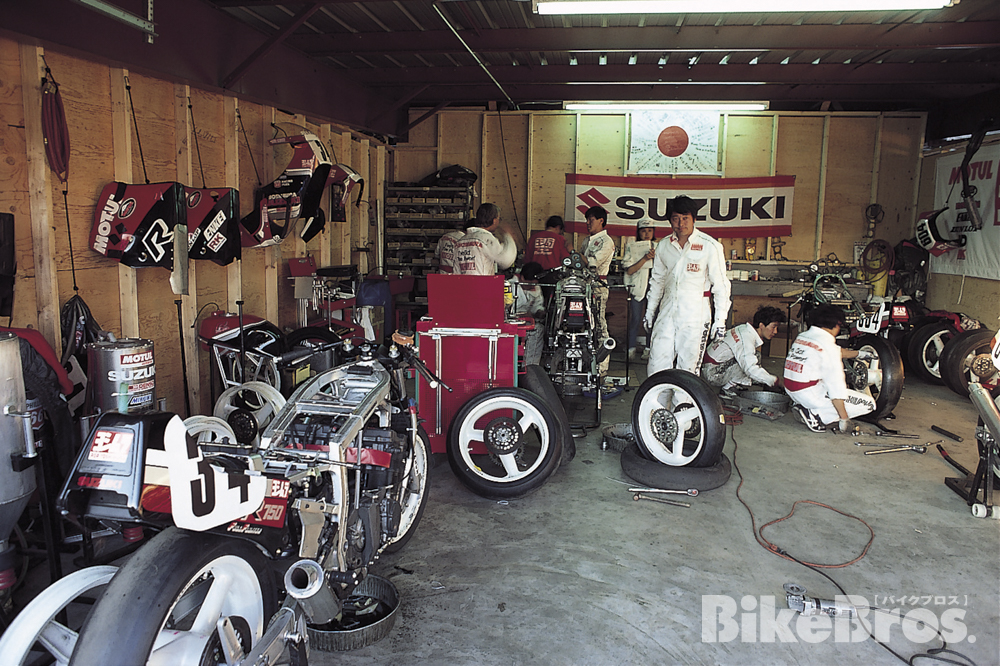
Yoshimura’s garage at Daytona Speedway looked like a battlefield. Standing in the center is Suehiro Watanabe. All entrants were locked out of the facility at 8 p.m. for security reasons, so Yoshimura team hauled the bikes to the nearby Holiday Inn hotel room where they were staying and continued to work on the bikes all night.
Tsujimoto visited the United States for the first time to attend the Suzuki GSX-R750 unveiling event in Laguna Seca Raceway (in Central California) on November 5. The launch of the bike in North America came a year later than in Europe and Japan, and it made its AMA Superbike debut in the 1986 season opener at Daytona Speedway.
Following the GSX-R750 launch at Laguna Seca, Yoshimura Suzuki riders Kevin Schwantz and Tsujimoto entered the final round of the AFM West Coast Superbike series at Willow Springs Raceway (in Southern California) on November 10. In the main Superbike race, Kevin Schwantz, riding his new oil-cooled GSX-R750, easily took the victory. Meanwhile, Tsujimoto entered the 750 Super Street race on Scott Gray’s Yoshimura Superbike-spec air-cooled GS700 (essentially the same as the GSX750) and took the checkered flag at the top, but was subsequently disqualified due to a breach of the technical regulations for using a non-stock generator. Tsujimoto also raced in the Open GP class, and although he came from behind to catch up, he was unable to finish on the podium due to a lack of laps (even a Superbike is required to complete a minimum of 8 laps). Tsujimoto thus finished his first American races.
Tsujimoto returned to Japan and came back to the United States just one week later to participate in a pre-test at the Daytona International Speedway (in Florida). It was the test for the Daytona 200 Mile, the biggest motorcycle race in the country, which was to be held in March 1986.
The Daytona road course features transitions from the 31-degree banking in the east/west turns to the 18-degree banking in front of the grandstands and to the completely flat infield turns, along with its slippery surface. It’s a difficult racetrack to ride, where high-speed sections make up about 70% of the course, but Tsujimoto somehow liked it.
High speeds were Tsujimoto’s obsession, and he loved power-sliding. His lap times were not bad either. One person who was especially interested in Tsujimoto’s Daytona challenge was Pop’s second daughter, Yumiko.
Yumiko’s husband, the late Shohei Kato, challenged Daytona Superbike (50-mile) in 1978 on a Yoshimura Suzuki GS750/944 and briefly took the lead in the final race, but was forced out of the race due to a CDI failure while running 2nd. At Daytona —— and only at Daytona —— Shohei wore a white Hinomaru (Japanese flag) racing suit featuring red suns, along with the katakana Yoshimura logos, on the chest and back. The suit design has history, and it was meant to be worn at special occasions. With this in mind, Yumiko entrusted Tsujimoto with a new Hinomaru suit (tailored by Kushitani). Tsujimoto was only the second Japanese Yoshimura rider after Shohei to race at Daytona.
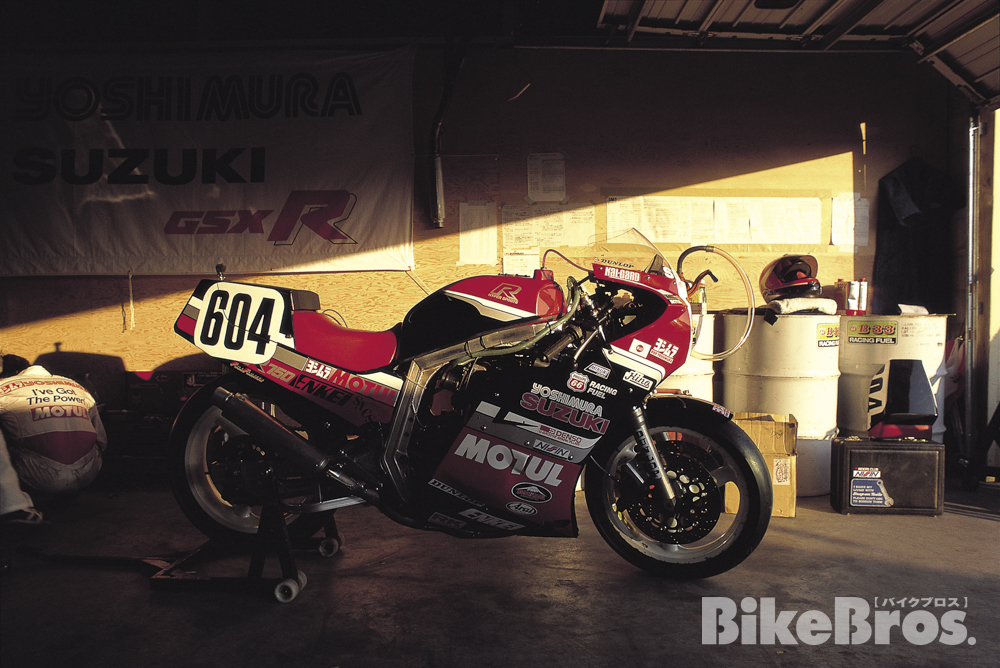
Tsujimoto’s GSX-750 sporting the number 604 and ready to race. The AMA’s guideline on the racing numbers in road racing specified that 2 digits numbers are for regular AMA road-racing members (e.g., #34 Kevin Schwantz, the rule does not apply to flat-track racing), the numbers in the 100s are for riders who are AMA members but are not currently regular road-racing members (e.g., #129 Jay Springsteen), and the numbers in the 600s are assigned to foreign riders who do not hold an AMA license (e.g., #604 Tsujimoto and #633 Kork Ballington).
The Daytona 200 was switched from U.S. Formula One (750cc 2-stroke and 1025cc 4-stroke) to Superbike in 1985, and 1986 was the second year of the transformation. After all, in the United States, 4-strokes are way more popular than 2-strokes, and it was a natural progression for Superbikes —— that are more closely related to production models —— to play the leading role. The Daytona Superbike in March increased its distance from 50 miles (from 1975 to 1978) to 100 miles (from 1979 to 1984), then to 200 miles (from 1985 onward) with a requirement of two pit stops (to accomplish two refuels and one rear tire change).
Tsujimoto and the GSX-R750 were prepared for a sprint endurance-like race at very high speeds. However, no one could have imagined that so many strong competitors would be present at the race.
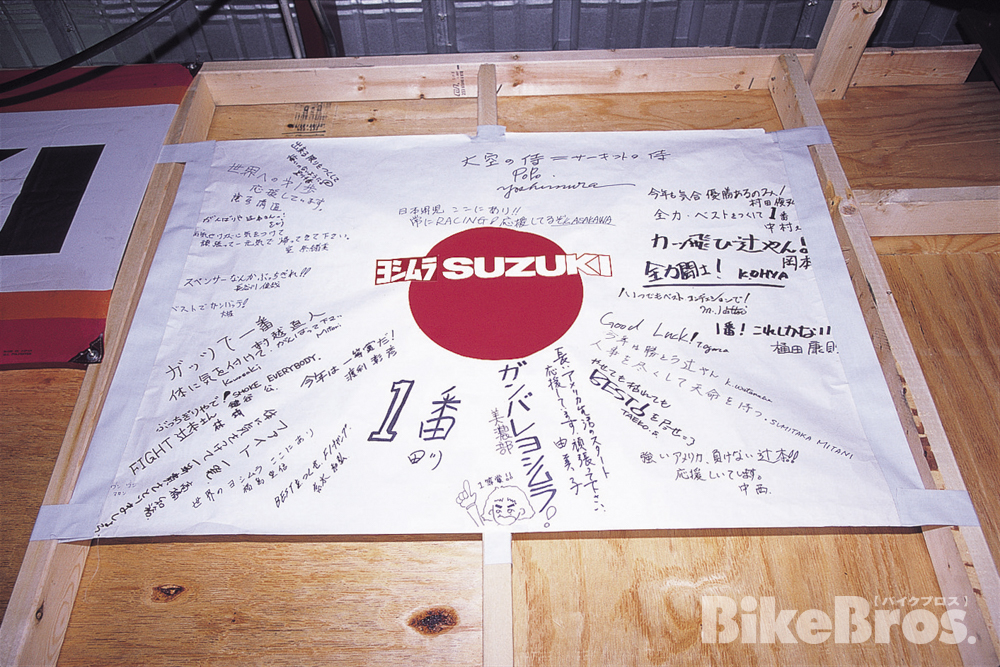
Yoshimura employees and staff wrote messages of good luck on a Japanese flag which was then displayed on their garage wall in Daytona. The message on the top reads, “Samurai of the Sky: Samurai of the Racetrack, Pops Yoshimura”.
============================================================
Published on October 21, 2022
Stories and photos supplied by Yoshimura Japan / Shigeo Kibiki / Takao Isobe / Tatsuo Sakurai
Written by Tomoya Ishibashi
Edited by Bike Bros Magazines
[ Japanese Page ]
